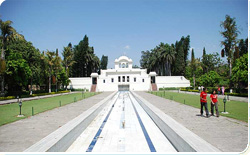 Pinjore Gardens, also called Yadavindra Gardens are 20 km from Chandigarh, 15 km from Panchkula, on the Chandigarh Shimla road. Taxis and buses ply regularly between Pinjore, Kalka, Panchkula and Chandigarh. Pinjore lies on the foothills of the lower Shivalik ranges. The fascinating Mughal Gardens one of the most popular picnic spots. A mini zoo, plants nursery, a Japanese garden, historic palaces and picnic lawns await tourists. Especially at weekends, fountains are switched on and after dusk, lights pick up the beauty of the palaces by night.
Pinjore Gardens, also called Yadavindra Gardens are 20 km from Chandigarh, 15 km from Panchkula, on the Chandigarh Shimla road. Taxis and buses ply regularly between Pinjore, Kalka, Panchkula and Chandigarh. Pinjore lies on the foothills of the lower Shivalik ranges. The fascinating Mughal Gardens one of the most popular picnic spots. A mini zoo, plants nursery, a Japanese garden, historic palaces and picnic lawns await tourists. Especially at weekends, fountains are switched on and after dusk, lights pick up the beauty of the palaces by night.
Special programs are arranged at the Yadavindra Gardens for the Baisakhi (spring) festival in April and for the Mango Festival in June and July. A range of accommodation is available at Chandigarh, but a taste of royalty can be savored at Pinjore itself by a stay at the Yadavindra Gardens Budgerigar Motel, run by Haryana Tourism. A Bhima Devi Temple and an old baoli in the Pinjore town have legendary connection with Pandavs and Mahabharat.
The gardens have cool, shady walks and flagged pathways which run to the outer reaches of the creeper-covered walls. The end structure of the doorway has recently been made into a disc-like open-air theatre. The stiff outer wall of the garden is reminiscent of the fort walls, which has now all around dieter pavilions housing the zoo. Palm trees, shapely cypresses, Mango and dense groves of trees add a touch of mystery to the Yadavindra Gardens of Pinjore. A watercourse traipsing from level to level sparkles in the sunlight, its pools reflecting white shining pavilions and balconies etched high against a blue sky. The graceful arched balconies and tinkling fountains, luxuriant green lawns and murmuring watercourse, limpid pools, shady walks and colorful flowerbeds, unusual descending terraces and monumental gateways—all were carefully planned to create a special effect.
Unlike other Mughal gardens, the seven terraces at Pinjore, instead of ascending, descend into the distance and achieve an almost magical effect. In the near distance, the purple-green Himalayas seem to rise up sheer over the battlements of the old garden walls and the white buildings of the little hill station of Kasauli in Himachal Pradesh, glow in the setting sun. From the stately Sheesh Mahal built in the Rajasthani–Mughal style, the watercourse with its never-ending bubbling music cascades from terrace to terrace, flowing under the towering Rang Mahal, and then playing around the Jal Mahal. The structures date to the 17th century AD.
Nawab Fadai Khan, a great architect and foster brother of the Mughal emperor Aurangzeb is said to have designed the idyllic gardens. He planned the Gardens on the classical Charbagh pattern, giving the area a central water way. Both sides of this waterway were covered with patches of green bordered with flowers and shaded by trees. He supervised the construction of the stylistic Sheesh Mahal (palace of glass), the Rang Mahal (painted palace), and the cube-like Jal Mahal (palace of water). After Fadai Khan’s departure and the end of Mughal rule, these gardens he had so lovingly designed was overtaken by the wilderness. His Highness Maharaja Yadavindra Singh of Patiala (Punjab) is said to have restored Pinjore Garden to its former glory.
